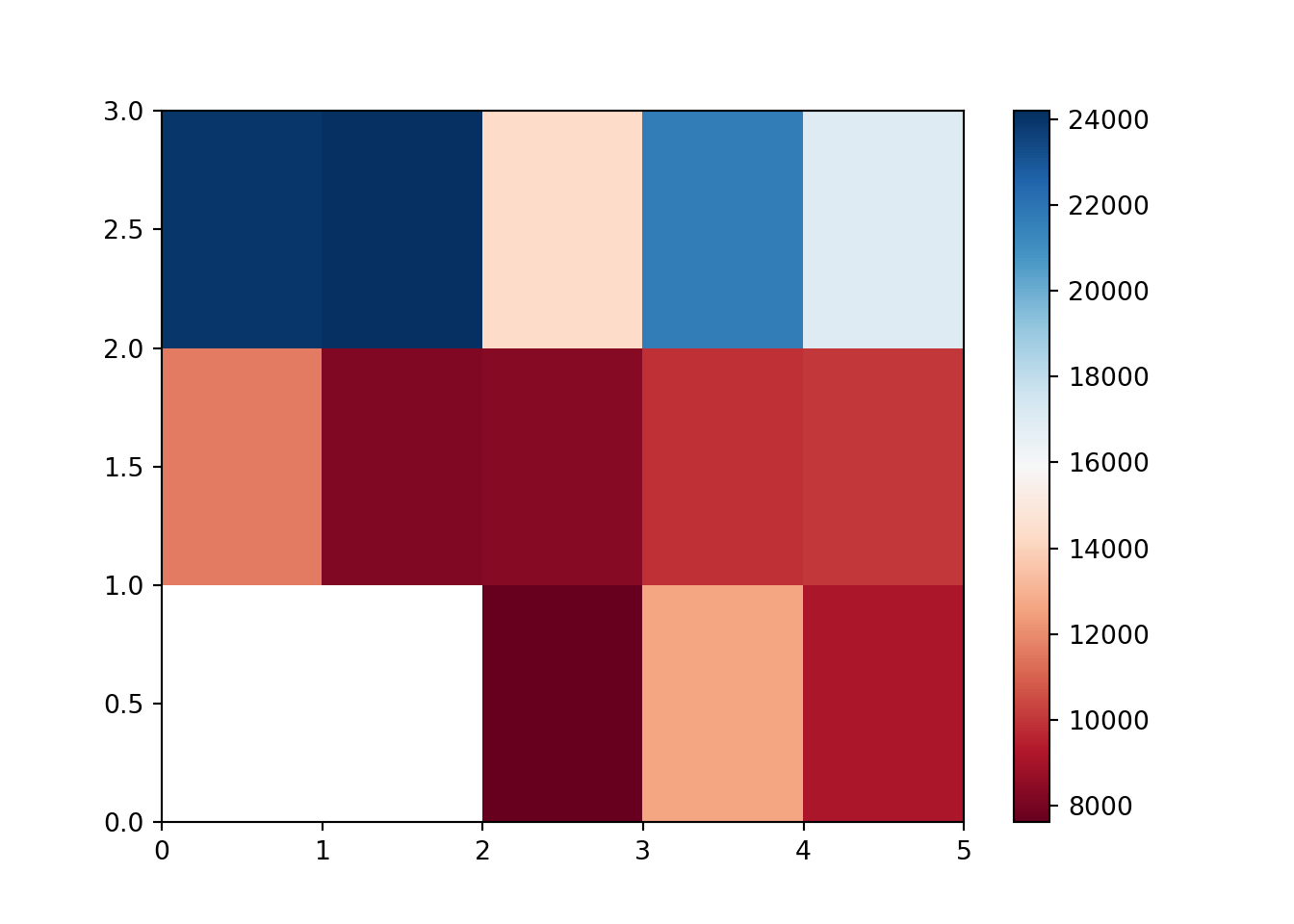Visualização de dados
By R. O. Perdiz in Python AED Plot Operações
June 19, 2024
Carregando módulos Python e lendo os dados
import pandas as pd
pd.__version__
## '2.2.2'
import numpy as np
dad = pd.read_csv("https://archive.ics.uci.edu/ml/machine-learning-databases/autos/imports-85.data", header = None)
headers = ["symboling", "normalized-losses", "make", "fuel-type", "aspiration", "num-of-doors", "body-style", "drive-wheels", "engine-location", "wheel-base", "length", "width", "height", "curb-weight", "engine-type", "num-of-cylinders", "engine-size", "fuel-system", "bore", "stroke", "compression-ratio", "horsepower", "peak-rpm", "city-mpg", "highway-mpg", "price"]
dad.columns = headers
dad.head(5)
## symboling normalized-losses make ... city-mpg highway-mpg price
## 0 3 ? alfa-romero ... 21 27 13495
## 1 3 ? alfa-romero ... 21 27 16500
## 2 1 ? alfa-romero ... 19 26 16500
## 3 2 164 audi ... 24 30 13950
## 4 2 164 audi ... 18 22 17450
##
## [5 rows x 26 columns]
Conversão de variáveis para tipo numérico
Algumas vezes, os dados não são automaticamente convertidos para o tipo de informação correta.
Por exemplo, preço do carro (“price”) foi lido como um “object”, isto é, pode conter palavras, letras, caracteres. Porém, trata-se de um número de fato.
Então, vamos convertê-lo usando o método to_numeric().
dad["price"] = pd.to_numeric(dad["price"], errors = "coerce")
Há outras variáveis assim também. Vejam:
dad[["horsepower"]].dtypes
## horsepower object
## dtype: object
dad[["normalized-losses"]].dtypes
## normalized-losses object
## dtype: object
dad["horsepower"] = pd.to_numeric(dad["horsepower"], errors = "coerce")
dad["normalized-losses"] = pd.to_numeric(dad["normalized-losses"], errors = "coerce")
Operações
Média
Para calcular a média de uma coluna, usamos o método mean().
Vamos testar com as colunas “price” e “normalized-losses”.
dad[["price"]].mean()
## price 13207.129353
## dtype: float64
dad["normalized-losses"].mean()
## 122.0
Valores únicos
dad["make"].unique()
## array(['alfa-romero', 'audi', 'bmw', 'chevrolet', 'dodge', 'honda',
## 'isuzu', 'jaguar', 'mazda', 'mercedes-benz', 'mercury',
## 'mitsubishi', 'nissan', 'peugot', 'plymouth', 'porsche', 'renault',
## 'saab', 'subaru', 'toyota', 'volkswagen', 'volvo'], dtype=object)
Correlações
dad.corr(numeric_only = True)
## symboling normalized-losses ... highway-mpg price
## symboling 1.000000 0.528667 ... 0.034606 -0.082391
## normalized-losses 0.528667 1.000000 ... -0.210768 0.203254
## wheel-base -0.531954 -0.074362 ... -0.544082 0.584642
## length -0.357612 0.023220 ... -0.704662 0.690628
## width -0.232919 0.105073 ... -0.677218 0.751265
## height -0.541038 -0.432335 ... -0.107358 0.135486
## curb-weight -0.227691 0.119893 ... -0.797465 0.834415
## engine-size -0.105790 0.167365 ... -0.677470 0.872335
## compression-ratio -0.178515 -0.132654 ... 0.265201 0.071107
## horsepower 0.071622 0.295772 ... -0.770908 0.810533
## city-mpg -0.035823 -0.258502 ... 0.971337 -0.686571
## highway-mpg 0.034606 -0.210768 ... 1.000000 -0.704692
## price -0.082391 0.203254 ... -0.704692 1.000000
##
## [13 rows x 13 columns]
Coeficiente de correlação de Pearson
from scipy.stats import pearsonr
pearsonr(dad["horsepower"], dad["price"])
## ValueError: array must not contain infs or NaNs
Há valores ausentes nas colunas. Vamos removê-las:
dad.dropna(subset = ["price"], axis = 0, inplace = True)
dad.dropna(subset = ["horsepower"], axis = 0, inplace = True)
pearson_coef, p_value = pearsonr(dad["horsepower"], dad["price"])
Coeficiente de correlação de Pearson é:
pearson_coef
## 0.8105330821322065
Já o valor de p é:
p_value
## 1.1891278276944886e-47
Agrupamentos
Utilizamos o método groupby().
Vamos ver como os preços de carros se apresentam entre essas duas variáveis, “drive-wheels” e “body-style”.
dados_parciais = dad[["drive-wheels", "body-style", "price"]]
dados_parciais
## drive-wheels body-style price
## 0 rwd convertible 13495.0
## 1 rwd convertible 16500.0
## 2 rwd hatchback 16500.0
## 3 fwd sedan 13950.0
## 4 4wd sedan 17450.0
## .. ... ... ...
## 200 rwd sedan 16845.0
## 201 rwd sedan 19045.0
## 202 rwd sedan 21485.0
## 203 rwd sedan 22470.0
## 204 rwd sedan 22625.0
##
## [199 rows x 3 columns]
dados_grupos = dados_parciais.groupby(["drive-wheels", "body-style"], as_index = False).mean()
dados_grupos
## drive-wheels body-style price
## 0 4wd hatchback 7603.000000
## 1 4wd sedan 12647.333333
## 2 4wd wagon 9095.750000
## 3 fwd convertible 11595.000000
## 4 fwd hardtop 8249.000000
## 5 fwd hatchback 8365.166667
## 6 fwd sedan 9811.800000
## 7 fwd wagon 10061.181818
## 8 rwd convertible 23949.600000
## 9 rwd hardtop 24202.714286
## 10 rwd hatchback 14337.777778
## 11 rwd sedan 21711.833333
## 12 rwd wagon 16994.222222
Tabelas dinâmicas (==“Pivot table”)
Criamos tabelas dinâmicas por meio do método pivot().
Em uma tabela dinâmica, temos uma variável ao longo das linhas, enquanto outra variável aparece nas colunas.
dados_dinamicos = dados_grupos.pivot(index = "drive-wheels", columns = "body-style")
dados_dinamicos
## price ...
## body-style convertible hardtop ... sedan wagon
## drive-wheels ...
## 4wd NaN NaN ... 12647.333333 9095.750000
## fwd 11595.0 8249.000000 ... 9811.800000 10061.181818
## rwd 23949.6 24202.714286 ... 21711.833333 16994.222222
##
## [3 rows x 5 columns]
Podemos preencher valores faltantes com 0, para facilitar a visualização dos dados:
dados_dinamicos.fillna(0)
## price ...
## body-style convertible hardtop ... sedan wagon
## drive-wheels ...
## 4wd 0.0 0.000000 ... 12647.333333 9095.750000
## fwd 11595.0 8249.000000 ... 9811.800000 10061.181818
## rwd 23949.6 24202.714286 ... 21711.833333 16994.222222
##
## [3 rows x 5 columns]
Importando módulos para visualização de dados
from matplotlib import pyplot as plt
import seaborn as sns
Visualização
Linhas
x = [1, 2, 3, 4]
y = [1, 4, 9, 6]
plt.plot(x, y)
plt.show()

Dispersão
plt.scatter(dad["engine-size"], dad["price"])
plt.title("Dispersão entre tamanho do motor e preço do veículo")
plt.xlabel("Tamanho do motor")
plt.ylabel("Preço")
plt.show()
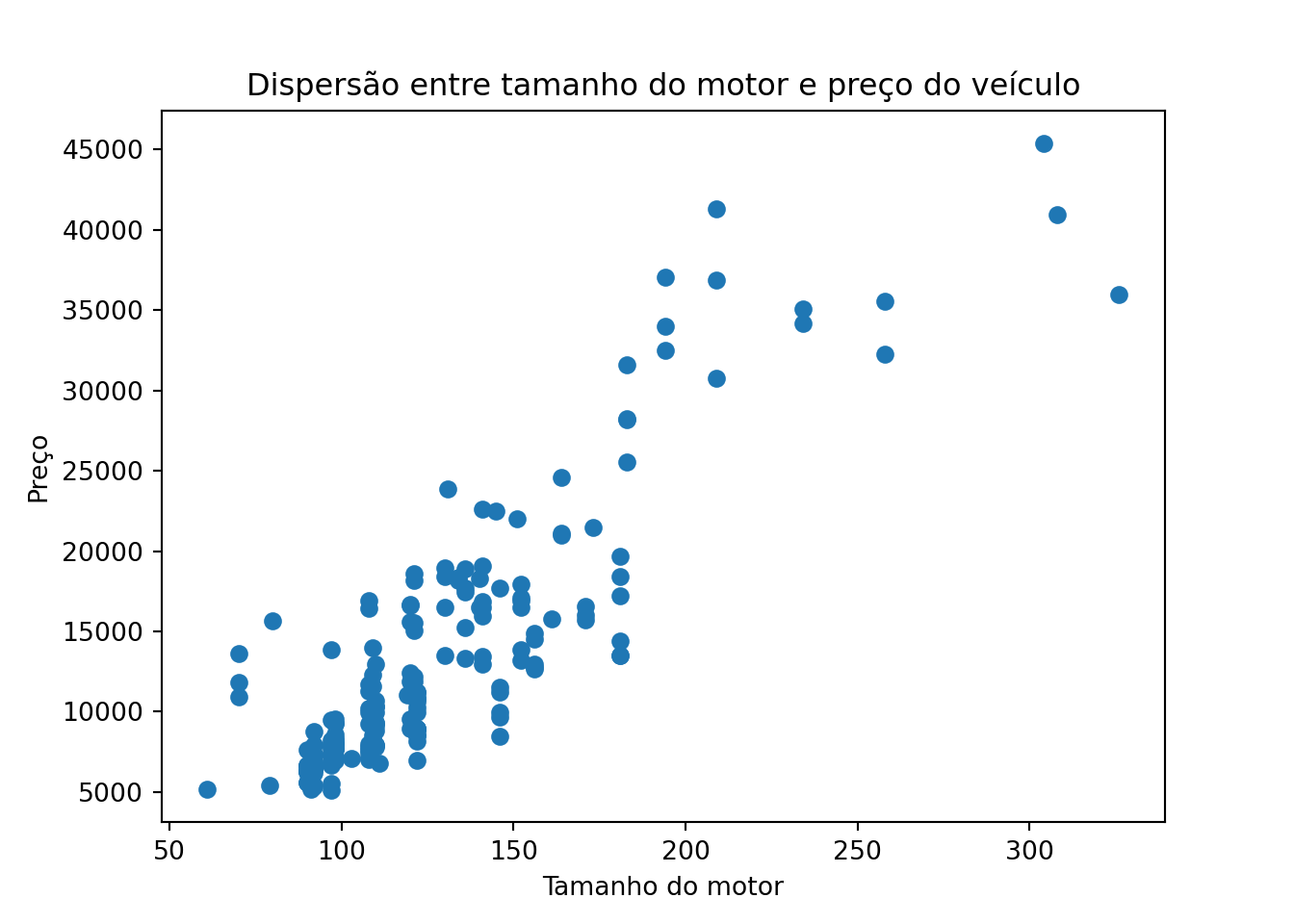
Histograma
plt.hist("engine-size", data = dad)
plt.show()
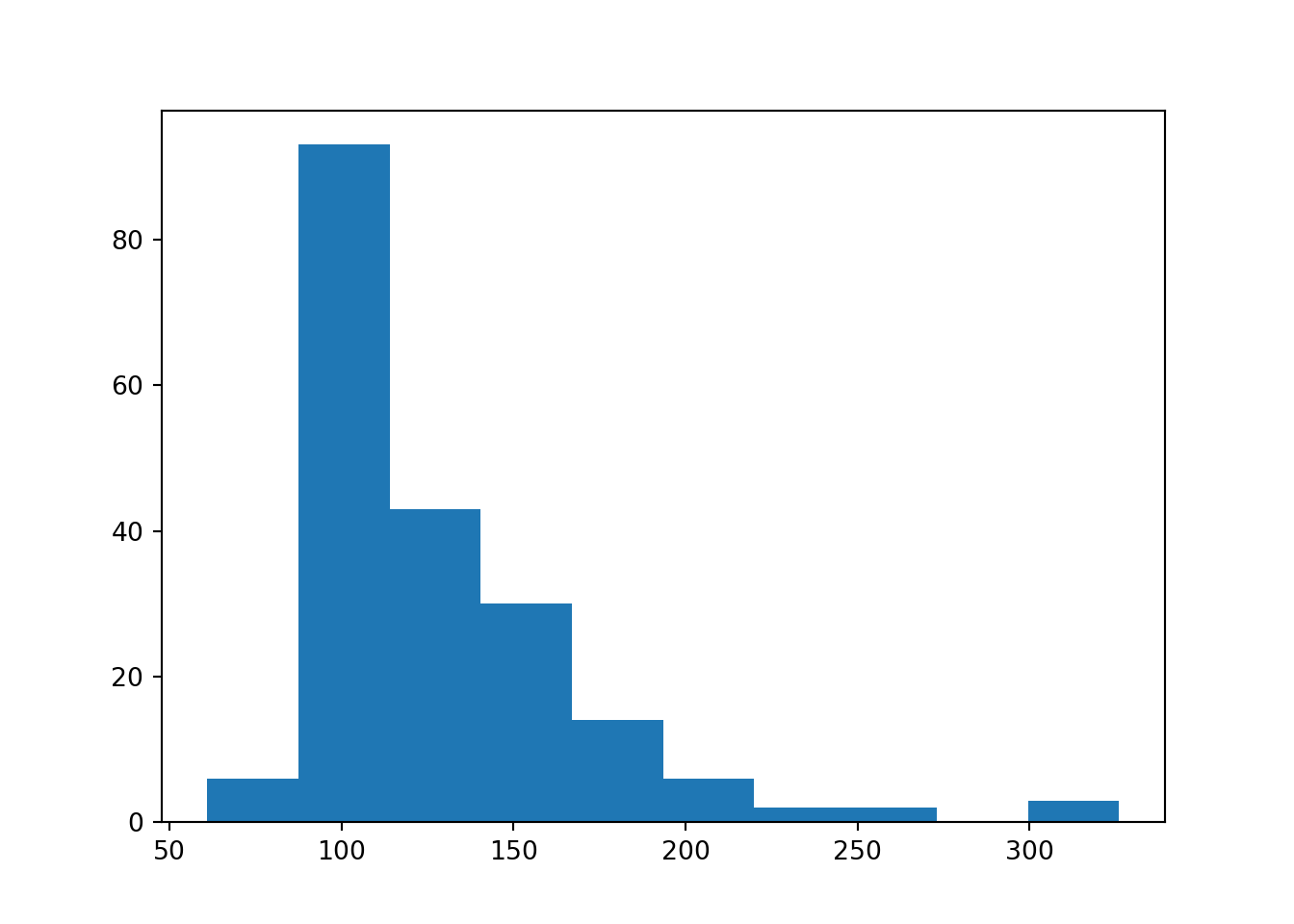
Densidade
sns.displot(data = dad, x = "engine-size", kind = "kde")
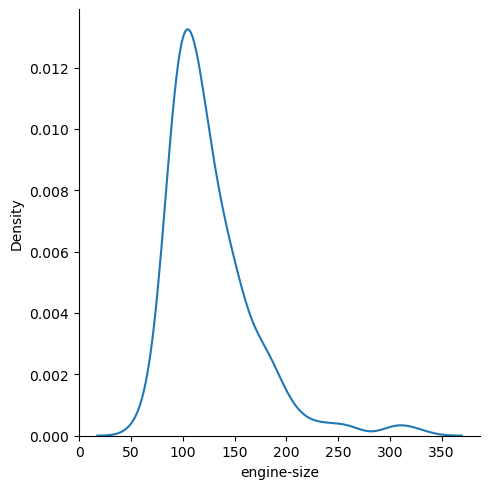
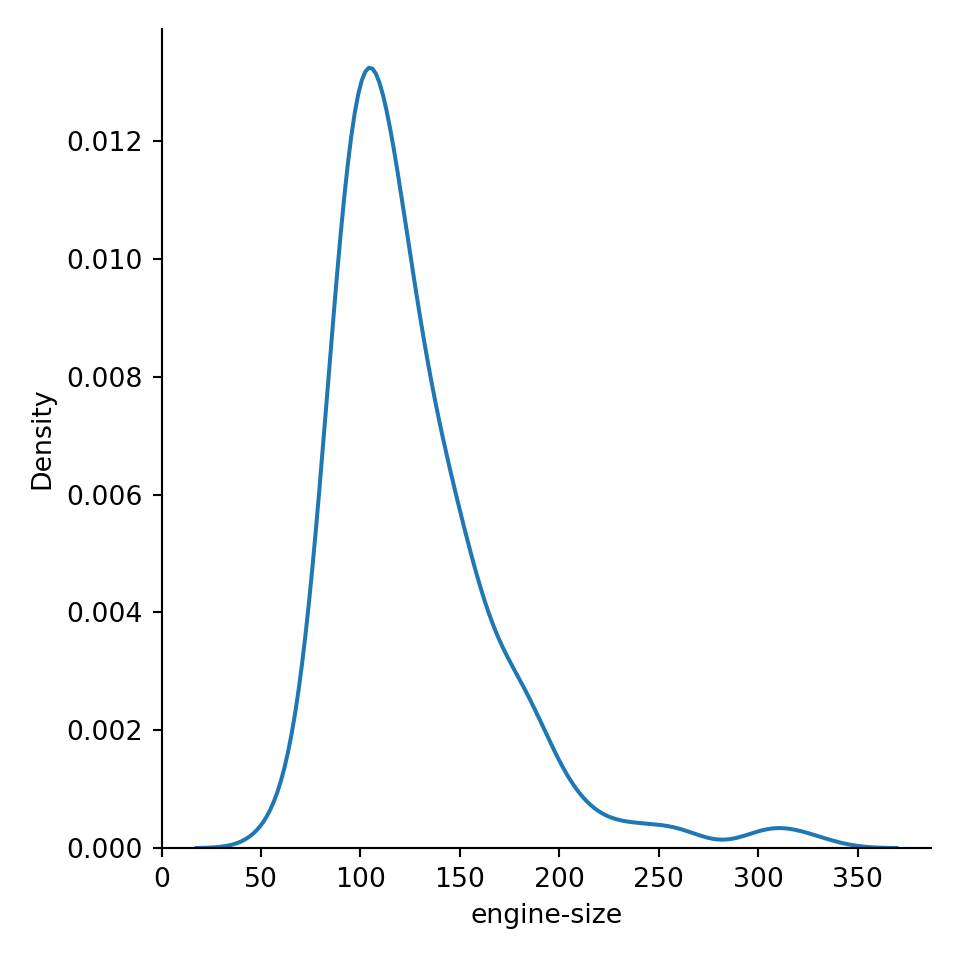
Barras
plt.bar("make","engine-size", data = dad)
plt.show()
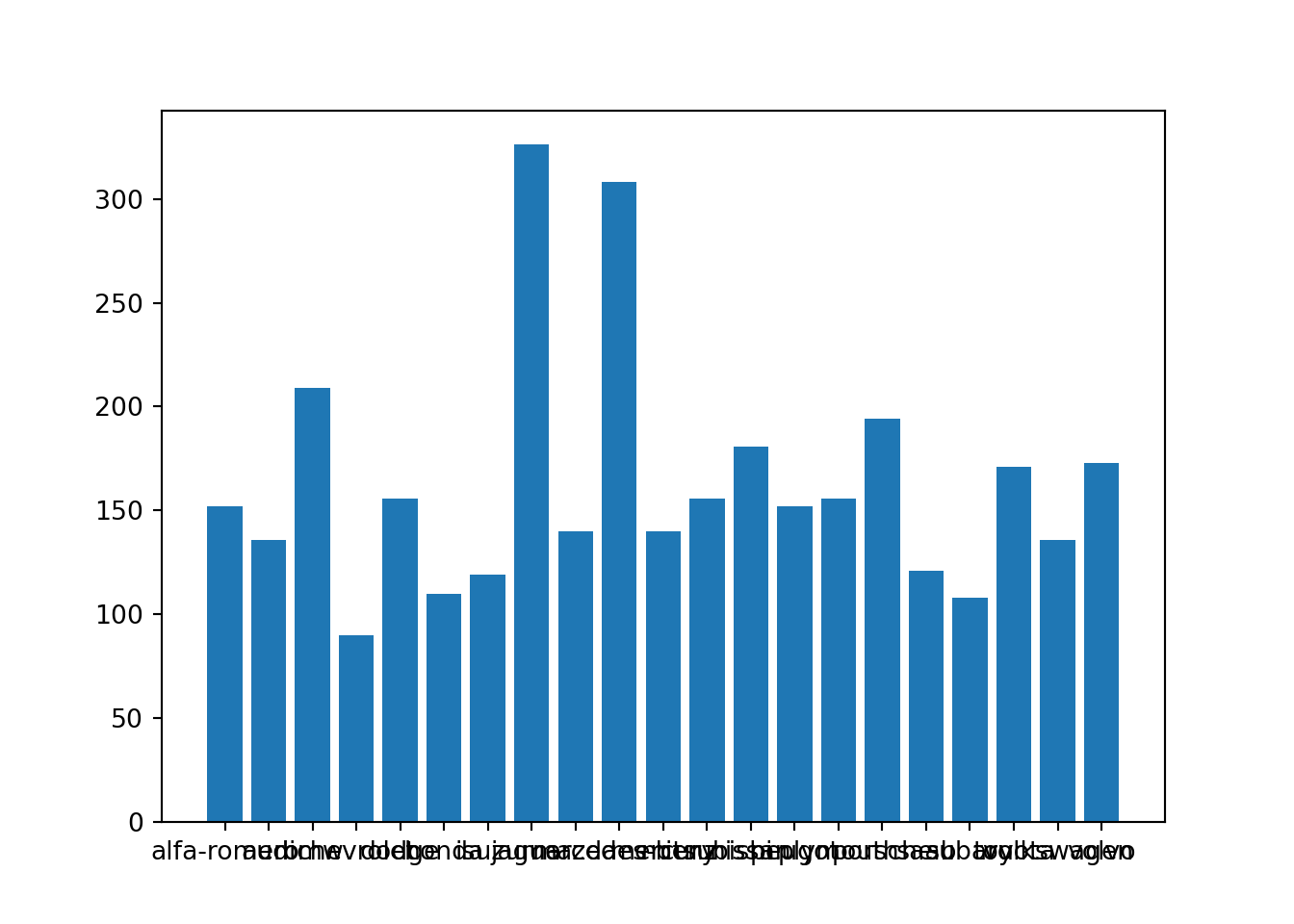
Rotaciona nomes do eixo X
plt.bar("make","engine-size", data = dad)
plt.xticks(rotation=90)
## ([0, 1, 2, 3, 4, 5, 6, 7, 8, 9, 10, 11, 12, 13, 14, 15, 16, 17, 18, 19, 20], [Text(0, 0, 'alfa-romero'), Text(1, 0, 'audi'), Text(2, 0, 'bmw'), Text(3, 0, 'chevrolet'), Text(4, 0, 'dodge'), Text(5, 0, 'honda'), Text(6, 0, 'isuzu'), Text(7, 0, 'jaguar'), Text(8, 0, 'mazda'), Text(9, 0, 'mercedes-benz'), Text(10, 0, 'mercury'), Text(11, 0, 'mitsubishi'), Text(12, 0, 'nissan'), Text(13, 0, 'peugot'), Text(14, 0, 'plymouth'), Text(15, 0, 'porsche'), Text(16, 0, 'saab'), Text(17, 0, 'subaru'), Text(18, 0, 'toyota'), Text(19, 0, 'volkswagen'), Text(20, 0, 'volvo')])
plt.show()
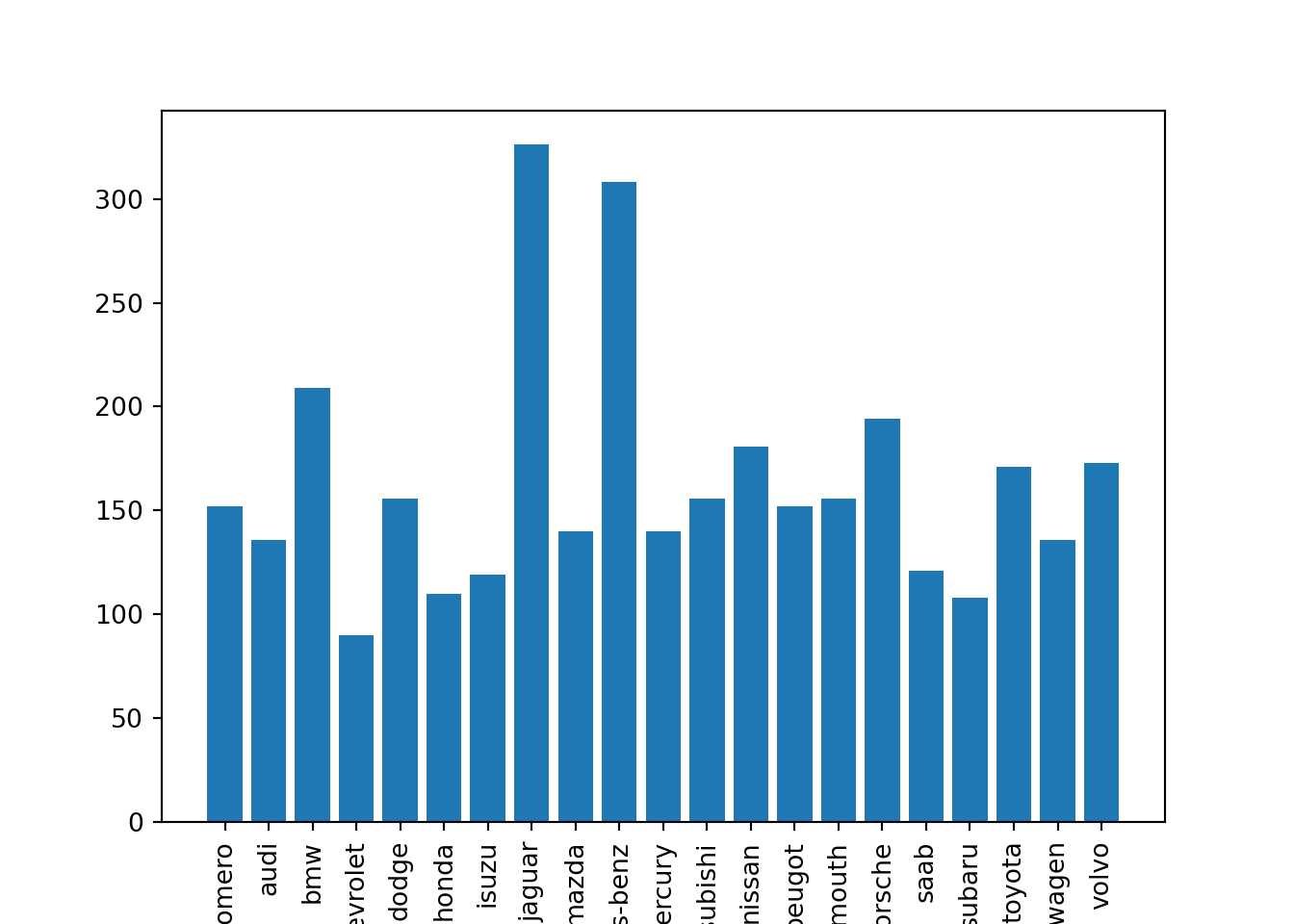
Dispersão com linha de regressão linear
sns.regplot(x = "engine-size", y = "price",data = dad)
plt.ylim(0, )
## (0.0, 53434.45110178258)
plt.show()
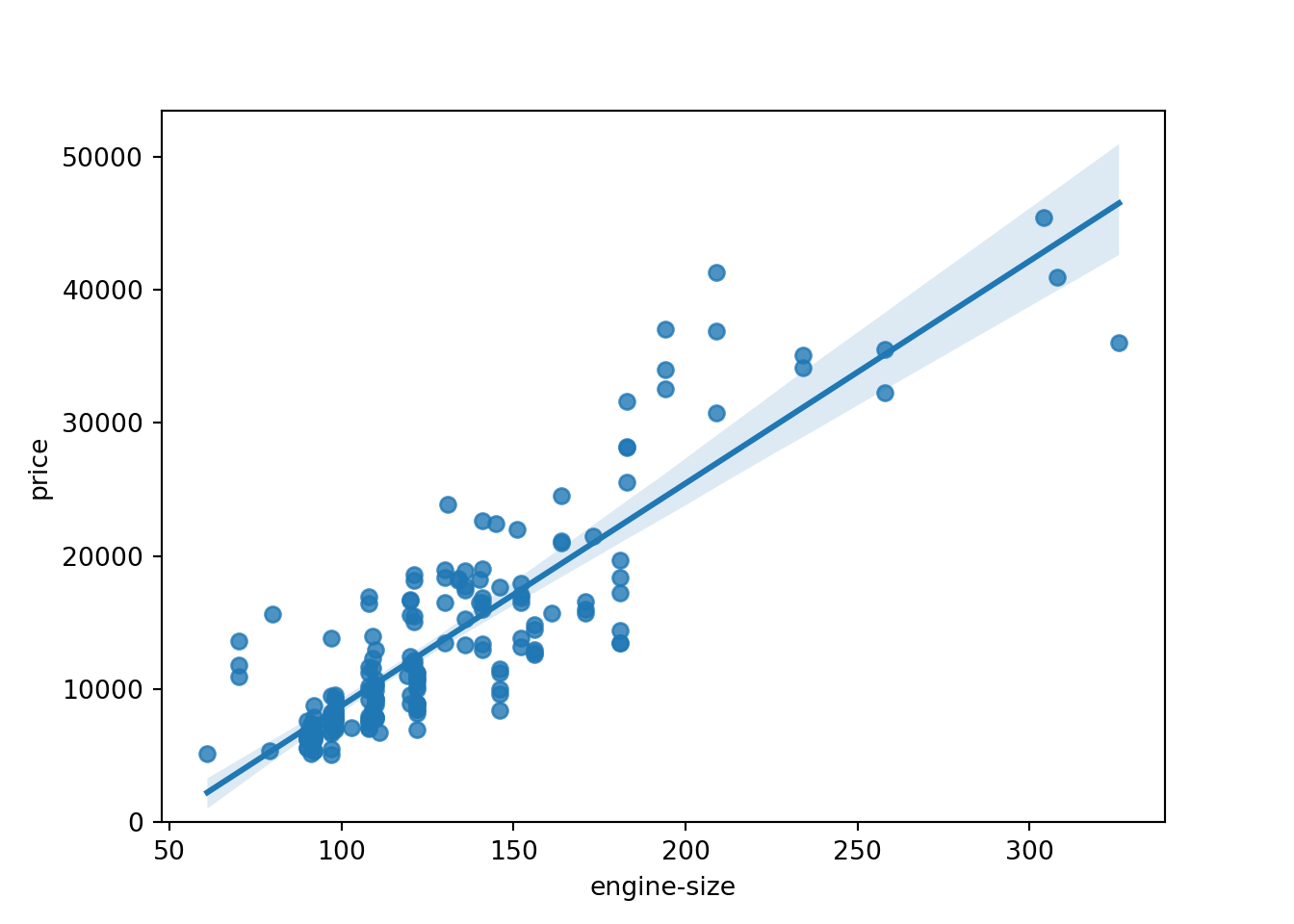
Boxplot
sns.boxplot(x = "make", y = "engine-size", data = dad)
plt.show()
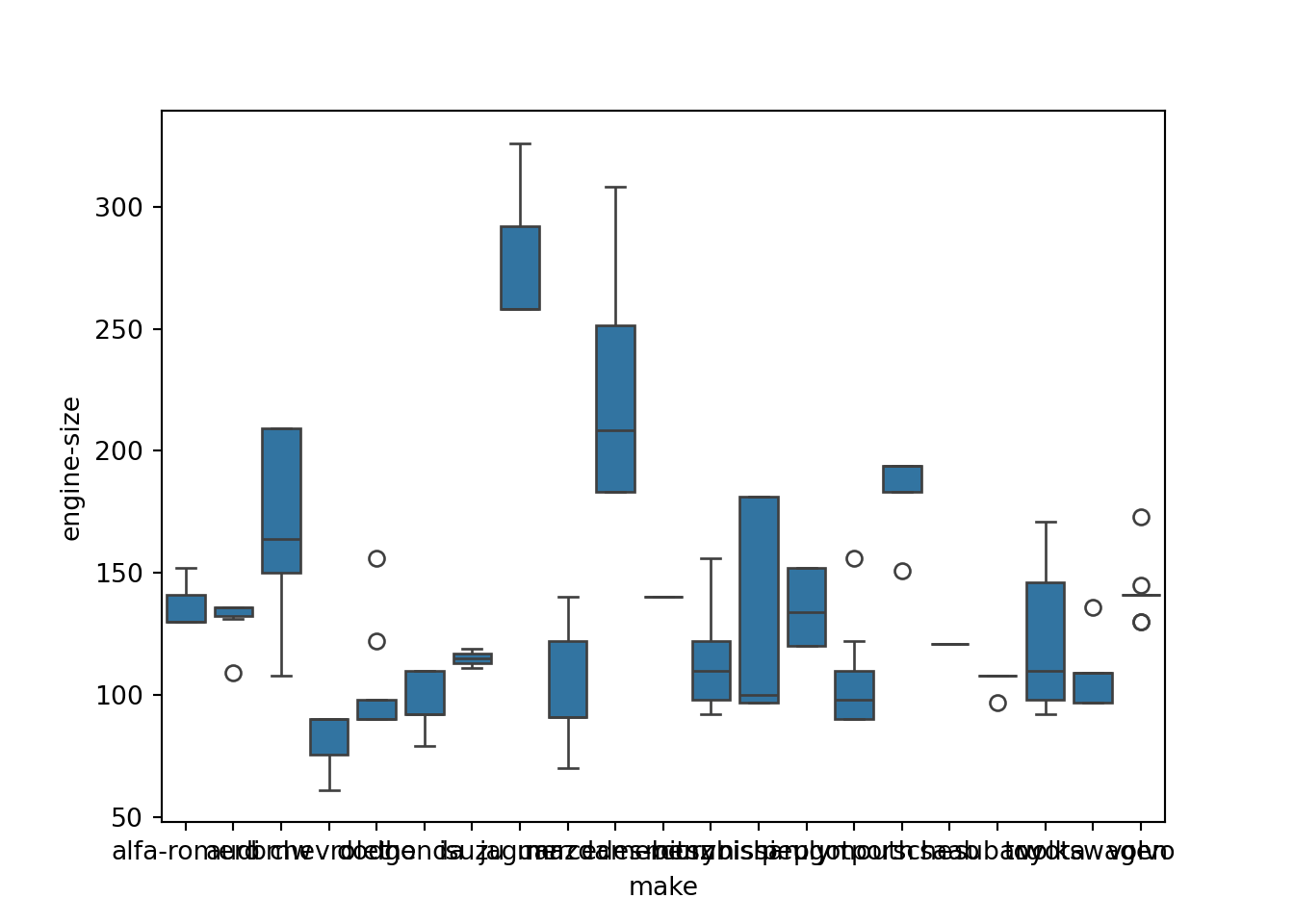
Rotaciona nomes do eixo X
Maneira 1
bplot = sns.boxplot(x = "make", y = "engine-size", data = dad)
bplot.set_xticklabels(bplot.get_xticklabels(), rotation = 45)
plt.show()
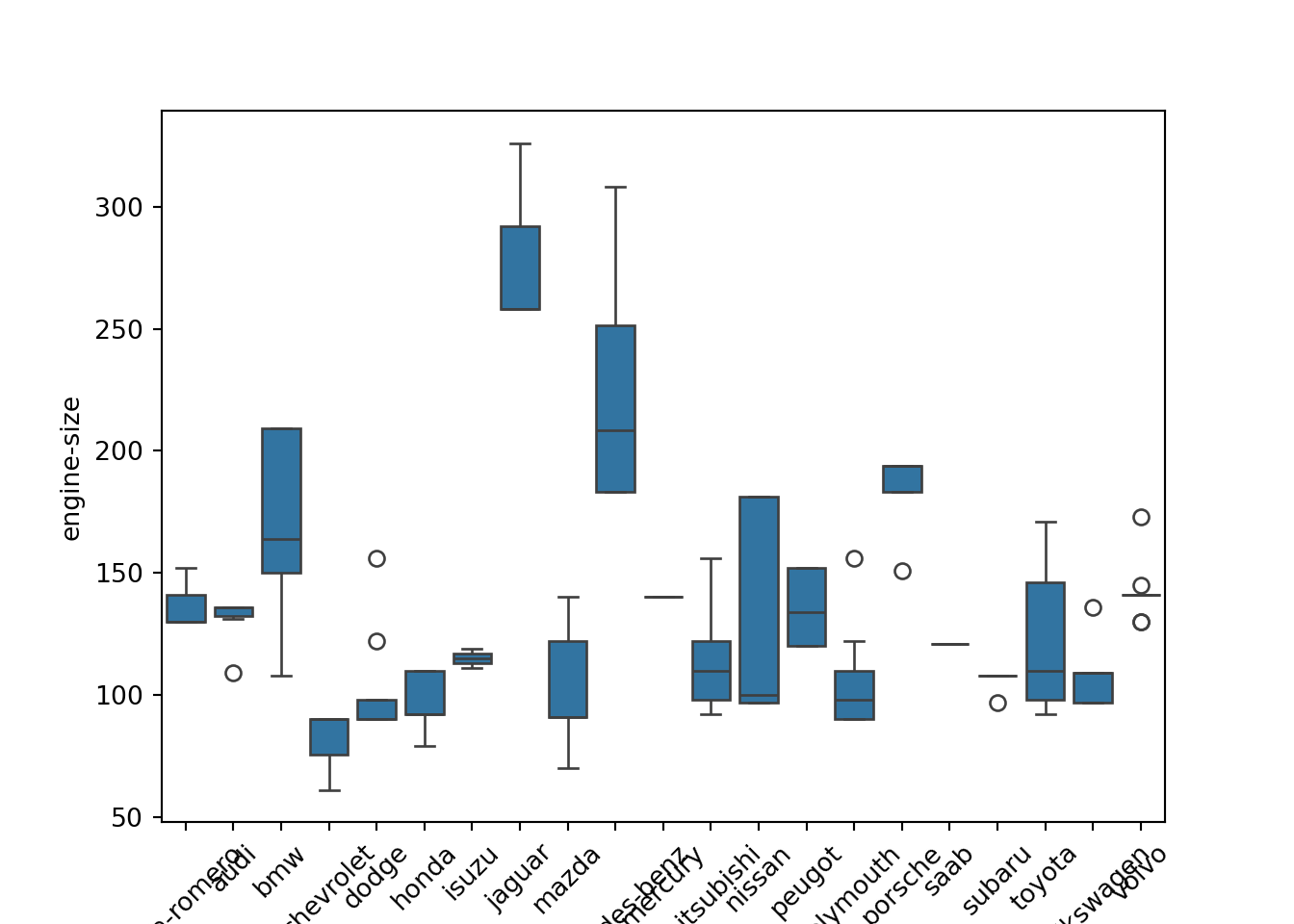
Maneira 2
sns.boxplot(x = "make", y = "engine-size", data = dad)
plt.xticks(rotation = 45)
## ([0, 1, 2, 3, 4, 5, 6, 7, 8, 9, 10, 11, 12, 13, 14, 15, 16, 17, 18, 19, 20], [Text(0, 0, 'alfa-romero'), Text(1, 0, 'audi'), Text(2, 0, 'bmw'), Text(3, 0, 'chevrolet'), Text(4, 0, 'dodge'), Text(5, 0, 'honda'), Text(6, 0, 'isuzu'), Text(7, 0, 'jaguar'), Text(8, 0, 'mazda'), Text(9, 0, 'mercedes-benz'), Text(10, 0, 'mercury'), Text(11, 0, 'mitsubishi'), Text(12, 0, 'nissan'), Text(13, 0, 'peugot'), Text(14, 0, 'plymouth'), Text(15, 0, 'porsche'), Text(16, 0, 'saab'), Text(17, 0, 'subaru'), Text(18, 0, 'toyota'), Text(19, 0, 'volkswagen'), Text(20, 0, 'volvo')])
plt.show()
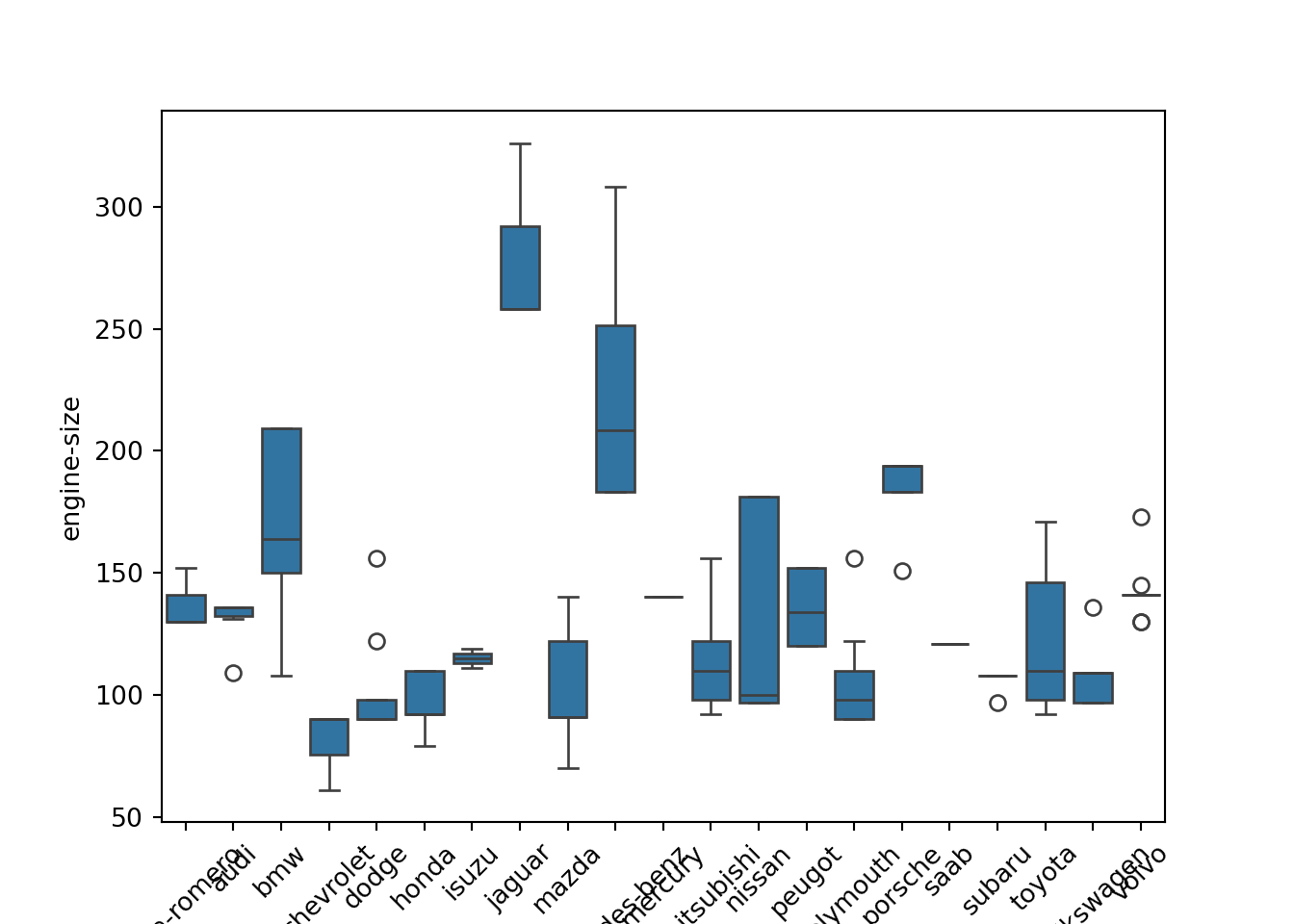
Mapa de calor
plt.pcolor(dados_dinamicos, cmap = "RdBu")
plt.colorbar()
## <string>:1: MatplotlibDeprecationWarning: Getting the array from a PolyQuadMesh will return the full array in the future (uncompressed). To get this behavior now set the PolyQuadMesh with a 2D array .set_array(data2d).
## <matplotlib.colorbar.Colorbar object at 0x0000016EB2B10C70>
plt.show()
